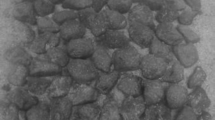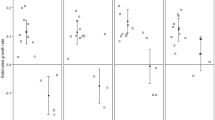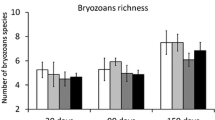Summary
Knowledge of predation intensity and how and why it varies among communities appears to be a key to understanding of community regulation. Along the rocky shores of New England, predation intensity in the mid intertidal zone appears to be low with exposure to severe wave shock, low desiccation stress, and a sparse cover of canopy algae, and high at areas protected from waves, with high desiccation potential and a dense cover of algae. As a result, predators at exposed headlands have no controlling influence on community structure, while at protected sites, they exert a strong and controlling effect on community structure.
Experimental-observational studies of the effects of wave shock and desiccation on survival, foraging range and activity of the primary predator in this community (Thais lapillus) indicate that:
-
(1)
wave shock is a continuous and actual source of mortality at exposed sites but is relatively unimportant at protected sites;
-
(2)
mortality rates from desiccation at protected sites are potentially high and greater than at exposed sites; however,
-
(3)
actual desiccation stress is greatly reduced at protected sites by a dense algal canopy;
-
(4)
mortality from desiccation is greater in the higher mid intertidal than in the lower mid intertidal.
Comparisons of activity patterns of Thais from April through November (these snails are usually active from May to early October) at an exposed and a protected site suggest snails at the former site restrict their active feeding to crevices while those at the latter site forage throughout the habitat. Field experiments support this hypothesis. Hence, differences in predator effectiveness at exposed and protected communities are probably due in part to the influence of wave shock. Exposed areas receive frequent severe wave shock in all seasons, even summer. Thus, the risk of being swept off the shore for snails foraging away from the shelter of a crevice at such areas is apparently great and exerts a strong selective force on foraging range. The importance of waves as a selective agent is further reinforced by the fact that crevices are nearly barren of prey, while just a few cm beyond the limits of the crevice, prey occur in great abundance.
In contrast, at protected sites wave shock is never as severe as at exposed sites and is a relatively minor factor among several which might affect the foraging activity of a Thais. A major factor which varies among protected sites is the algal canopy. The influence of this factor is considered in a companion paper.
Similar content being viewed by others
References
Anonymous: Local climatological data for Boston, Mass. National Oceanic and Atmospheric Administration; Environmental Data Service (1965–1975)
Connell, J.H.: Effects of competition, predation by Thais lapillus, and other factors on natural populations of the barnacle Balanus balanoides. Ecol. Monogr. 31, 61–104 (1961a)
Connell, J.H.: The influence of interspecific competition and other factors on the distribution of the barnacle Chthamalus stellatus. Ecology 42, 710–723 (1961b)
Connell, J.H.: A predator-prey system in the marine intertidal region. I. Balanus glandula and several predatory species of Thais. Ecol. Monogr. 40, 49–78 (1970)
Connell, J.H.: On the role of natural enemies in preventing competitive exclusion in some marine animals and in rain forest trees. Proc. Advance. Stud. Inst., Dynamics Numbers Pop. 1970, 298–312 (1971)
Connell, J.H.: Some mechanisms producing structure in natural communities. In: Ecology and evolution of communities (M.L. Cody, J.M. Diamond, eds.), pp. 460–490. Cambridge, Mass.: Harvard Univ. Press 1975
Dayton, P.K.: Competition, disturbance, and community organization: the provision and subsequent utilization of space in a rocky intertidal community. Ecol. Monogr. 41, 351–389 (1971)
Dayton, P.K.: Experimental evaluation of ecological dominance in a rocky intertidal algal community. Ecol. Monogr. 45, 137–159 (1975)
Dodson, S.I.: Complementary feeding niches sustained by size-selective predation. Limnol. Oceanogr 15, 131–137 (1970)
Dodson, S.I.: Adaptive change in plankton morphology in response to size-selective predation: a new hypothesis of cyclomorphosis. Limnol. Oceanogr. 19, 721–729 (1974a)
Dodson, S.I.: Zooplankton competition and predation: an experimental test of the size-efficiency hypothesis. Ecology 55, 605–613 (1974b)
Glynn, P.W.: Mass mortalities of echinoids and other reef flat organisms coincident with midday, low water exposures in Puerto Rico. Mar. Biol. 1, 226–243 (1968)
Harger, J.R.E.: The effect of wave impact on some aspects of the biology of sea mussels. The Veliger 12, 401–414 (1970)
Harger, J.R.E., Landenberger, D.E.: The effect of storms as a density dependent mortality factor on populations of sea mussels. The Veliger 14, 195–201 (1971)
Harper, J.L.: The role of predation in vegetational diversity. Brookhaven Symp. Biol. 22, 48–61 (1969)
Hatton, H.: Essais de bionomie explicative sur quelques especes intercotidales d'algues et d'animaux. Ann. Inst. Monaco 17, 241–348 (1938)
Huffaker, C.B.: Experimental studies on predation: dispersion factors and predator-prey oscillations. Hilgardia 27, 343–383 (1958)
Janzen, D.H.: Herbivores and the number of tree species in tropical forests. Am. Natur. 104, 501–528 (1970)
Kensler, C.B.: Desiccation resistance of intertidal crevice species as a factor in their zonation. J. Anim. Ecol. 36, 391–406 (1967)
Kohn, A.J.: Environmental complexity and species diversity in the gastropod genus Conus on Indo-West Pacific reef platforms. Am. Natur. 101, 251–260 (1967)
Kohn, A.J., Leviten, P.J.: Effect of habitat complexity on population density and species richness in tropical intertidal predatory gastropod assemblages. Oecologia (Berl.) 25, 199–210 (1976)
Levin, S.A., Paine, R.T.: Disturbance, patch formation, and community structure. Proc. Nat. Acad. Sci., U.S. 71, 2744–2747 (1974)
Lewis, J.R.: The ecology of rocky shores, pp. 323. London: English Universities Press 1964
Loucks, O.L.: Evolution of diversity, efficiency, and community stability. Am. Zool. 10, 17–25 (1970)
Lubchenco, J. (formerly Menge, J. Lubchenco): Plant species diversity in a marine intertidal community: importance of herbivore food preference and algal competitive abilities. Am. Natur. 112, (in press, 1978)
Lubchenco, J., Menge, B.A.: Community development and persistence in a low rocky intertidal zone. Ecol. Monogr. (in press, 1978)
MacArthur, R.H.: Geographical ecology, 269 pp. New York: Harper and Row 1972
MacArthur, R.H., MacArthur, J.W.: On bird species diversity. Ecology 42, 594–598 (1961)
Menge, B.A.: Foraging strategy of a starfish in relation to actual prey availability and environmental predictability. Ecol. Monogr. 42, 25–50 (1972)
Menge, B.A.: Ecological implications of patterns of rocky intertidal community structure and behavior along an environmental gradient. In: Ecology of fouling communities (J.D. Costlow, ed.), pp. 155–180. Washington D.C.: Office of Naval Research Printing Office 1976a
Menge, B.A.: Organization of the New England rocky intertidal community: role of predation, competition and environmental heterogeneity. Ecol. Monogr. 46, 355–393 (1976b)
Menge, B.A.: Predation intensity in a rocky intertidal community. Effect of an algal canopy, wave action and desiccation on predator feeding rates. Oecologia (Berl.) 34, 17–35 (1978)
Menge, B.A., Sutherland, J.P.: Species diversity gradients: synthesis of roles of predation, competition, and temporal heterogeneity. Am. Natur. 110, 351–369 (1976)
Menge, J.L.: Effect of herbivores on community structure of the New England rocky intertidal region: distribution, abundance and diversity of algae. Ph. D. Thesis, Harvard University, Cambridge, Mass. (1975)
Moore, H.B.: The biology of Purpura lapillus. Part 1. Shell variation in relation to the environment. J. Mar. Biol. Assoc. U.K. 21, 61–89 (1936)
Murdoch, W.W.: Switching in general predators: experiments on predator specificity and stability of prey populations. Ecol. Monogr. 39, 335–354 (1969)
Murdoch, W.W., Oaten, A.: Predation and population stability. Adv. Ecol. Res. 9, 1–131 (1975)
Oaten, A., Murdoch, W.W.: Functional response and stability in predator-pray systems. Am. Natur. 109, 289–298 (1975a)
Oaten, A., Murdoch, W.W.: Switching, functional response, and stability in predator-prey systems. Am. Natur. 109, 299–318 (1975b)
Osborne, C.: Ecology of shell color polyphenism in Thais lapillus. Ph. D. Thesis, Yale University, New Haven, Conn., 337 pp. (1977)
Osman, R.W.: The establishment and development of a marine epifaunal community. Ecol. Monogr. 47, 37–63 (1977)
Paine, R.T.: Food web complexity and species diversity. Am. Natur. 100, 65–75 (1966)
Paine, R.T.: The Pisaster-Tegula interaction: prey patches, predator food preference and intertidal community structure. Ecology 50, 950–961 (1969)
Paine, R.T.: A short-term experimental investigation of resource partitioning in a New Zealand rocky intertidal habitat. Ecology 52, 1096–1106 (1971)
Paine, R.T.: Intertidal community structure. Experimental studies on the relationship between a dominant competitor and its principal predator. Oecologia (Berl.) 15, 93–120 (1974)
Paine, R.T.: Size-limited predation: an observational and experimental approach with the Mytilus-Pisaster interaction. Ecology 57, 858–873 (1976)
Pianka, E.R.: On lizard species diversity: North American flatland deserts. Ecology 48, 333–351 (1967)
Roth, R.R.: Spatial heterogeneity and bird species diversity. Ecology 57, 773–782 (1976)
Southward, A.J.: The population balance between limpets and seaweeds on wave-beaten rocky shores. Rep. Mar. Biol. Sta. Pt. Erin, No. 8, 20–29 (1956)
Staiger, H.: Genetical and morphological variation in Purpura lapillus with respect to local and regional differentiation of population groups. Annee Biol. 33, 251–258 (1957)
Sprules, W.G.: Effects of size-selective predation and food competition on high altitude zooplankton communities. Ecology 53, 375–386 (1972)
Taylor, D.L.: Some ecological implications of forest fire control in Yellowstone National Park, Wyoming. Ecology 54, 1394–1396 (1973)
Ware, D.M.: Predation by rainbow trout (Salmo gairdneri): the influence of hunger, prey density, and prey size. J. Fish. Res. Board Canada 29, 1193–1201 (1972)
Wiens, J.A.: Pattern and process in grassland bird communities. Ecol. Monogr. 43, 237–270 (1973)
Wiens, J.A.: Habitat heterogeneity and avian community structure in North American grasslands. Am. Midl. Nat. 91, 195–213 (1974a)
Wiens, J.A.: Climatic instability and the “ecological saturation” of bird communities in North American grasslands. The Condor 76, 385–400 (1974b)
Author information
Authors and Affiliations
Rights and permissions
About this article
Cite this article
Menge, B.A. Predation intensity in a rocky intertidal community. Oecologia 34, 1–16 (1978). https://doi.org/10.1007/BF00346237
Received:
Issue Date:
DOI: https://doi.org/10.1007/BF00346237




